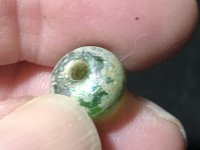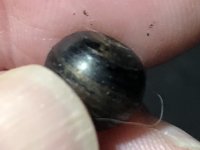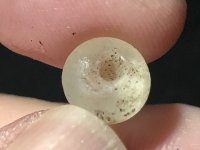My one spot in Virginia was settled in the 1660's by European settlers. That said, the one rise above a spring would have been a fairly good lookout spot for native Americans. The host rock is limestone in the Shenandoah Valley. That said, there was a ca 1850 house there that burned down in 1863 or 4. I found a shale/schist broken Indian gorget on the top of the hill. No points. So...I found these three beads there. I found these over the spring. Plz take a look.



They are apparently of European manufacture and are glass. The first one is clear and has wear near each hole, showing long use and the glass has somewhat frosted. The second is a very, very dark color. Sometimes it seems to be black and iridescent and other times dark green, depending on the lighting. The third is definitely green. They are about 3/8" in diameter.
The question is, are they trade beads or did they belong to the lady of the house? Thanks for looking.



They are apparently of European manufacture and are glass. The first one is clear and has wear near each hole, showing long use and the glass has somewhat frosted. The second is a very, very dark color. Sometimes it seems to be black and iridescent and other times dark green, depending on the lighting. The third is definitely green. They are about 3/8" in diameter.
The question is, are they trade beads or did they belong to the lady of the house? Thanks for looking.




